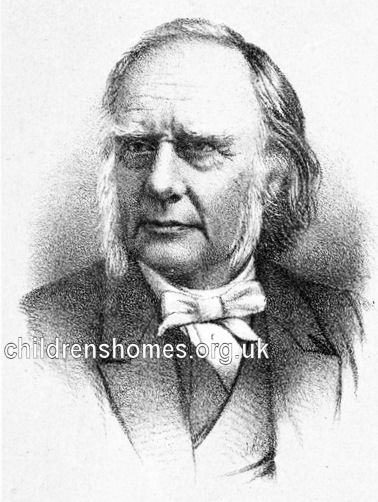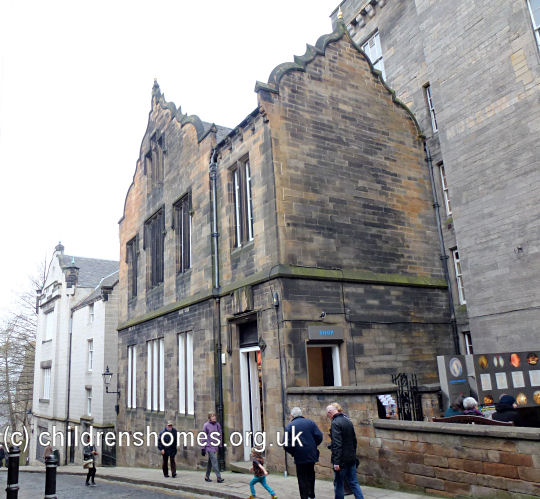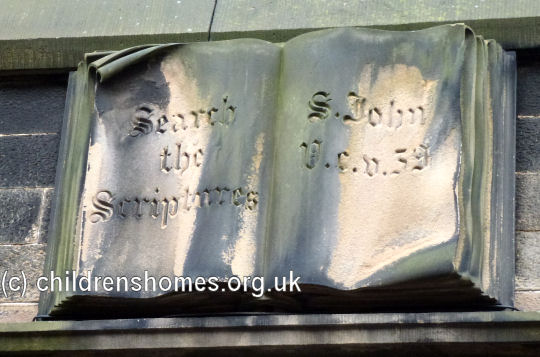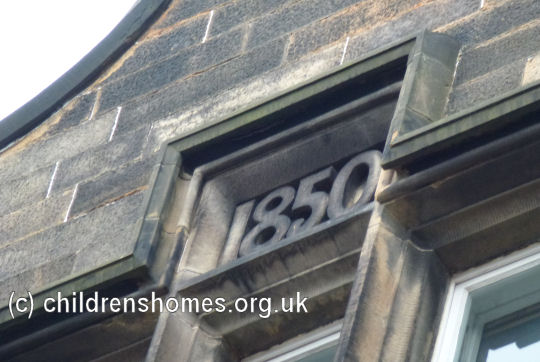Original Industrial School for Boys (Dr Guthrie's), Edinburgh, Midlothian, Scotland
Thomas Guthrie was born in Brechin in 1803. His father, David Guthrie, was a banker and merchant and served as Provost of Brechin for many years. Thomas was precocious and entered Edinburgh University at the age of 12, where over the next eight years he studied literature, philosophy, surgery, anatomy and divinity. He was licensed as a minister in 1827.

Thomas Guthrie. © Peter Higginbotham
In 1837, Guthrie was elected as joint minister at Edinburgh's Old Greyfriars Kirk where he witnessed the poverty and squalor of the city's Old Town, particularly amongst the children, many of whom lived by begging on the streets. Following the Disruption in 1843, Guthrie joined the Free Church and in 1845 moved to the moving into the newly built Free St John's on Johnston Terrace. Impressed by the growing Ragged Schools movement in England, and the Ragged School opened in Aberdeen in 1841 by Sheriff William Watson, Guthrie proposed his own 'ragged feeding industrial school' to provide for some of the Edinburgh's poorest children in a large room beneath the church. Despite support form the congregation, he scheme was vetoed, however, by 'some of our office-bearers'.
In 1847, Guthrie published the pamphlet Plea for Ragged Schools to encourage the founding of such establishments for the 'shoeless, shirtless, capless, ragged boys, as wild as desert savages.' The enormous support for his proposals led to the formation of the city's Ragged Industrial School Association and by the end of the year, three schools had been established in Edinburgh under Guthrie's auspices. They comprised a boys' school opened on 26 March on Ramsay Lane, a girls' school opened on 11 July at the junction of Castle Hill and Lawnmarket, and a mixed school in Warriston Close for children under ten years of age, with a total attendance of 265 children, who received food, education and industrial training. Guthrie's efforts did not meet universal approval as the style of religious instruction which Guthrie favoured was felt by some to discriminate against Roman Catholic pupils. As a result, a rival institution, known as the United Industrial School, was subsequently set up on South Gray's Close. Guthrie's establishment's then became known as the Original Ragged Industrial Schools. St Cuthbert's Parish, at the west of Edinburgh, opened a ragged and industrial school at 75 Morrison Street.
In May 1851, the three Guthrie schools came together with the opening of new premises on Ramsay Lane. The new building, which became the boys' department, contained a large school-room, with a small one adjoining, two large work-rooms, a wash-house, bath, store-room etc. The former boys' school was then used as a girls' and infant school, with the Lawnmarket premises becoming girls' dormitories. On its day of opening, the number of children on the roll was just over 300.

Former Industrial School for Boys (Dr Guthrie's), Edinburgh, 2013. © Peter Higginbotham

Former Industrial School for Boys (Dr Guthrie's), Edinburgh, 2013. © Peter Higginbotham

Former Industrial School for Boys (Dr Guthrie's), Edinburgh, 2013. © Peter Higginbotham
On June 2 1855, the Ramsay Lane establishment was formally accredited under Dunlop's Act as a Reformatory (later reassigned as an Industrial School), allowing it to receive children who, for a variety of reasons, could be sentenced by magistrates to a period of confinement.
In 1858, the school acquired a property known as Marionville on Lochend Road (now Marionville Road) between Edinburgh and Restalrig. The house and its four acres of land were used as an annexe to the main site, where the older boys under detention could be given training in agricultural, horticultural and other outdoor work. The boys also had a band. Marionville was closed in 1870.
An inspection of the Ramsay Lane site in 1862 expressed a wish that the appearance of the buildings was plainer and that the children were not dressed in uniform (provided by the school) while in attendance. Industrial work at that date included tailoring, and paper and fancy box making.
An 1870 inspection recorded that 228 children were present, of whom 79 boys and 22 girls were committed cases, the remainder being day scholars, including 47 in the infant schools. About 30 boys and 35 girls were now lodged in an adjoining building which had recently been purchased, and that 70 boys and 6 girls were lodged in private houses.
In 1875, the girls were removed from Ramsay Lane to new purpose-built accommodation at Leith Walk, Edinburgh.
For a period, the schools made use of a small house in Burntisland, Fife, for delicate and convalescent children. This establishment was closed in 1884.
An inspection in 1884 noted that the boys either slept in an adjoining building (presumably part of the former girls' department) or in flats in Mound Place, where a good deal of supervision was required. condition. The health of the inmates was generally satisfactory, with two deaths in the year, one from typhoid fever and one from consumption. There had been many cases of ophthalmia, two accidental injuries, a few cases of cold and bronchitis, and one of rheumatism, Two boys had been discharged on account of disease. As regards conduct and discipline, there had been a few cases of badly inclined boys getting into bad company and going out of bounds without leave. Two had been sent to Reformatory School for gross misconduct. There were classes for tailoring and shoemaking, paper and card-box making, and joinery work. The boys assisted in the work of the laundry, kitchen, and house. There was a good band, with a party of pipers in suitable costume. The staff at that date comprised: superintendent, Mr William Henderson; assistant superintendent, Mr Thomas Lawson; senior teacher, Mr Adam Forbes; junior, Mr Adam Mackie; janitor, joiner, tailor, shoemaker; matron, Miss Janet Robertson; sewing maid, laundress, cook, mistress of infant department, Miss Rachel Neish.
The Ramsay Lane premises continued in use until 1887 when the boys moved to a new site a few miles out of the centre at Liberton.
Records
Note: many repositories impose a closure period of up to 100 years for records identifying individuals. Before travelling a long distance, always check that the records you want to consult will be available.
- National Records of Scotland, HM General Register House, 2 Princes Street, Edinburgh EH1 3YY. Holdings include: Admission registers (1849-1971); Admission papers, boys (1861-1936); Case files, boys (1940-1981); Committal orders, girls (1876-1899); Record books, boys (1875-1956); Licensing registers: boys (1962-70), girls (1964-70); Log books: boys (1969-1977), girls (1955-1986); Discharge registers (1879-1961); Visitors' books: boys (1859-1954), girls (1961-1984); Photographs (1930s-1970s); Minutes of meetings (1870-1965); Annual reports (1878-1986); Various administrative and financial records etc.
Census
Bibliography
- Higginbotham, Peter Children's Homes: A History of Institutional Care for Britain's Young (2017, Pen & Sword)
- Mahood, Linda Policing Gender, Class and Family: Britain, 1850-1940 (1995, Univeristy of Alberta Press)
- Prahms, Wendy Newcastle Ragged and Industrial School (2006, The History Press)
Links
- None noted at present.
Except where indicated, this page () © Peter Higginbotham. Contents may not be reproduced without permission.


